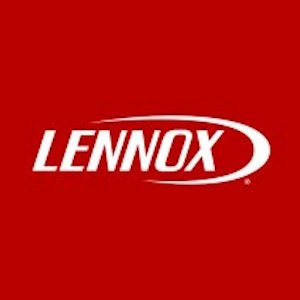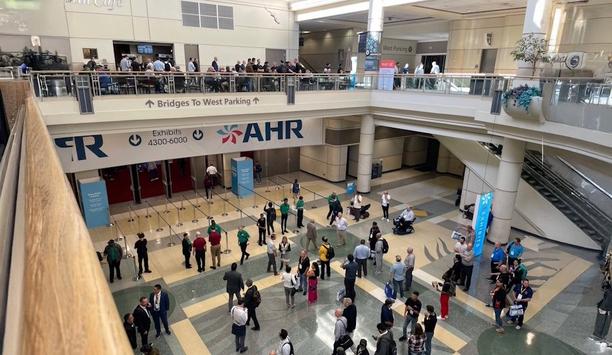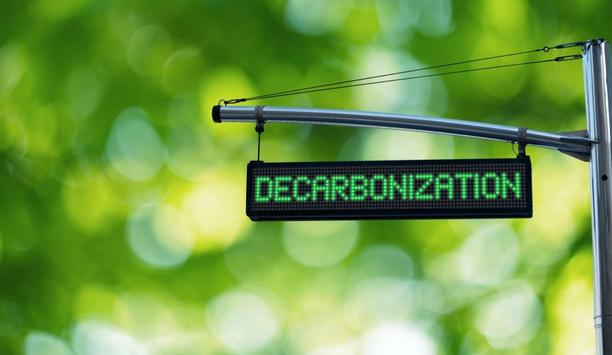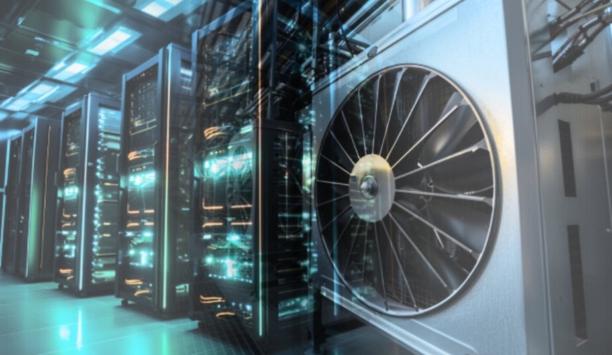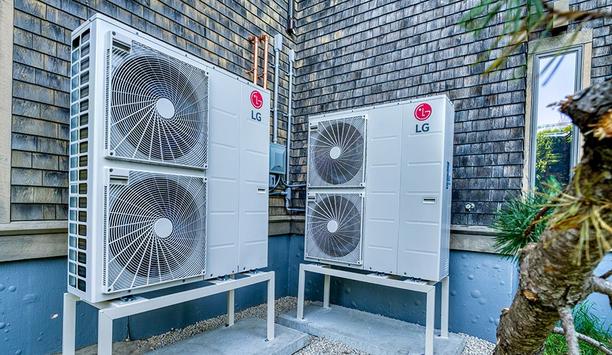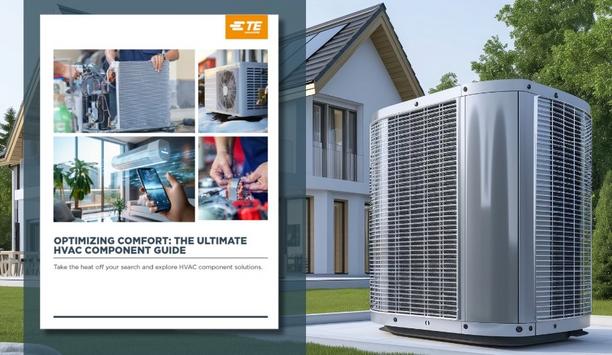Lennox - Experts & Thought Leaders
Latest Lennox news & announcements
Lennox EMEA is taking cooling performance to the next level by introducing a new range of computer room air handling units (CRAH) designed specifically for high-performance Data Center applications. The new CRAH-ApX Series, complete with adaptable design for tailored data center needs, provides hyperscale and co-location facilities with unparalleled cooling performance, efficiency and reliability. Advanced cooling solutions Hyperscale data centers are large business-critical facilities that process significant volumes of data, compute, and storage services. The deployment of advanced cooling solutions is critical to maintain optimal operating temperatures and reduce energy consumption. CRAH units are a go-to solution for circulating cool air through the server racks, and Lennox EMEA has taken a new approach to the application of the technology. Engineering-led design The modular design ensures seamless integration into various data center layouts The new CRAH-ApX Series chilled-water data center unit offers cooling capacity from 20 kW to 500 kW in both single and “back-to-back” arrangements. Featuring industry recognized controls and latest generation components, the modular design ensures seamless integration into various data center layouts, including raised floor and hard floor configurations. Options are available for 24 different size units. Design of heat exchangers “Our CRAH-ApX Series takes a different design path to that of conventional solutions,” explains Matt Evans, CEO. “It offers a number of robustly engineered standard case sizes, an approach that allows us to tailor the design. Internally, components such as the size and type of fans, the design of heat exchangers, optimally configured piping layouts, valves, and specific control requirements, can all be designed to suit the individual data center." Power requirements of the data center Lennox EMEA knows from experience that the power needs of each data center Evans added: "This flexibility and adaptability delivers a more tailored way of meeting precise application requirements, rather than simply offering the nearest-fit solution.” Lennox EMEA knows from experience that the power requirements of each data center rack vary enormously from site to site. As a result, the need for a more engineering-led, granular and versatile level of cooling design is evident. Maximum performance Energy efficiency is a cross-component theme with the CRAH-ApX Series. For instance, the advanced Lennox EMEA branded heat exchanger design ensures optimal performance by tailoring coil geometry, circuiting, fin type, material and pitch. Notably, Lennox EMEA has advanced capability of manufacturing heat exchangers, borne out from decades of market leading HVAC products, not only optimizing lead times but also reducing the carbon footprint and costs associated with transport. EC fan technology is utilized across the product-set with a range of sizes and options including integrated Active Power Factor Correction (APFC) for control of overall Total Harmonic Distortion (THDi). Take control of cooling Integrated fail-safe tools enable uninterrupted operation in the event of power failures With the option of a standard or advanced touchscreen control system, the CRAH-ApX Series provides wholistic monitoring, performance management, and integration with data center infrastructure solutions. The range comes equipped with industry standard networking protocols to control, monitor, and report operations such as fan speed, cooling performance, and alarms in real time. Integrated fail-safe mechanisms enable uninterrupted operation in the event of power failures, meeting the critical uptime requirements of data centers. Advanced control functionality The CRAH-ApX Series includes automatic transfer switches and ultra-capacitor back-up, enabling immediate fan restart following power restoration. Integrated unit-to-unit network communication is featured as standard allowing for advanced control functionality including teamwork modes, standby rotation, cascade operation, auto restart delay and rotating master function, all without the need of a dedicated sequencing panel. Program of products CRAH-ApX Series includes automatic transfer switches and ultra-capacitor back-up “The new CRAH-ApX Series further strengthens our commitment to delivering market-pioneering cooling solutions that support the operational demands of hyperscale and co-location data centers." "It is the first in a program of products designed specifically for next generation facilities,” says Matt Evans. New high-performance CRAH Backed by a team of highly skilled and experienced professionals, Lennox EMEA already provides a comprehensive range of scalable, high-efficiency cooling systems for high-performance data center environments. The addition of this new high-performance CRAH, along with the forthcoming CDU and FWU adds to an already strong portfolio which includes close control units (CCUs), computer room air handler (CRAH) units, fan wall units (FWU), coolant distribution units (CDUs), chillers and dry coolers, all backed by extensive aftersales support.
A combination cleaner-disinfectant from Decon7 Systems introduced just one year ago at the 2024 AHR Expo, has already made its mark with HVAC wholesalers and contractors interested in increasing their IAQ (indoor air quality) offerings and revenue. The EPA-registered product, D7, is affordable and easily applied to HVAC equipment during routine maintenance visits. This product-service offering adds a profitable revenue stream while improving IAQ for residential and commercial customers. IAQ awareness In the past year, Decon7 has significantly grown its presence in the HVAC industry, developing supplier partnerships with manufacturers including Carrier, York, and Lennox, as well as wholesalers such as Sigler, Standard Supply, CE, Johnstone Supply, Century, Johnson Controls and Howard Industries. As IAQ awareness continues to grow, contractors throughout the U.S. and Canada are augmenting their IAQ offerings with D7. D7 D7 is a powerful cleaner and disinfectant that eliminates up to 99.9999% of harmful pathogens D7 is a powerful cleaner and disinfectant that eliminates up to 99.9999% of harmful pathogens such as mold, bacteria, viruses, and mildew that collect in HVAC equipment and can cause health issues. Decon7’s product line for HVAC contractors will be on display at the 2025 AHR Expo in Orlando, Feb. 10-12, Booth #W-3285. This includes sprayers to clean and disinfect coils, foggers to deodorize ductwork, and a foaming device to clean and disinfect plumbing drains. BDAS+ New at AHR 2025, Decon7 is featuring a ready-to-use solution of D7 packaged in a dispenser for a single application. Called BDAS+, the water-based formula requires no mixing and is low-corrosive, making it safe and easy to use. BDAS+ is designed to effectively clean and disinfect mini-splits without the use of special tools. contractor revenue model Also featured at the AHR booth is an illustration of the contractor revenue model for D7 based on the number of trucks and service calls per day. For example, a company with a 50-truck operation using single application quart kits can expect to see margins between 80 and 95 percent, said Matt Bluhm, CEO of Decon7 Systems. indoor air quality improvements “We want contractors to see how adding D7 to their IAQ offerings brings a healthy profit margin,” Bluhm said. “We will also focus on the fact that D7 is easy to apply and can be added to maintenance service calls when the technician is already on the premises. D7 is also an important path to promoting indoor air quality improvements and a healthy home or building.” sanitizer and powerful cleaner This provides contractors with one of the most powerful solutions available to kill pathogens Unlike products on the market that only sanitize, D7 is a disinfectant, deodorizer, sanitizer, and powerful cleaner. This provides contractors with one of the most powerful solutions available to kill pathogens that collect in evaporator coils, drip pans, motor housings, and fan blades; it can also be fogged into ductwork for deodorization and foamed into drains as a deodorizer. proven disinfectant D7 is a proven disinfectant used in multiple industries to kill the toughest pathogens, including norovirus, SARS-Co-V2 (the virus that causes COVID-19), and bacteria such as Staph and Legionella. Additionally, D7 has been verified as effective in eliminating several types of molds including Aspergillus Niger (black mold). D7 is composed of mild ingredients with a pH close to neutral, making it safe on a wide range of surfaces in residential and commercial properties.
Lennox Residential HVAC, a trusted home comfort solutions and energy-efficiency innovator since 1895, announced the latest addition to its industry-renowned Dave Lennox Signature® Collection with the launch of the SL25KCV Air Conditioner, the most precise and efficient air conditioner available. A recent survey found that 81% of homeowners consider the installation of high-efficiency HVAC equipment to be either extremely or very important to them due to potential savings, with 91% reporting lower monthly bills as the most appealing advantage. Lennox SL25KCV Air Conditioner The Lennox SL25KCV Air Conditioner delivers an unmatched efficiency rating of up to 26.00 SEER2 (Seasonal Energy Efficiency Ratio 2) and can help lower energy bills while keeping the home cool and quiet. Additionally, its Precise Comfort® technology finely tunes and adjusts cooling output in tiny increments to perfectly match energy use, effortlessly meeting homeowners’ desire to help the planet and their wallets. HFC refrigerants The intro of the SL25KCV Air Conditioner precedes an upcoming industry-wide growth in unity with the AIM actThe introduction of the SL25KCV Air Conditioner precedes an upcoming industry-wide transition, in accordance with the American Innovation and Manufacturing (AIM) Act and U.S. Environmental Protection Agency (EPA), to phase down high-hydrofluorocarbon (HFC) refrigerants by using low global warming potential (GWP) alternatives. This change will take place on January 1, 2025. With substantially lower GWP than previous refrigerants, the launch of the SL25KCV Air Conditioner complies with updated EPA regulations and is formulated to provide peace of mind for years to come. 2025 Compliant Refrigerants As part of its relentless pursuit of staying ahead of industry standards, Lennox updated its entire product lineup to use 2025 Compliant Refrigerants and will continue rolling those products out over the next several months. "As the industry transitions to low GWP refrigerants, Lennox is introducing products that meet and exceed regulatory requirements, supporting both sustainability and operational efficiency," said Prakash Bedapudi, Chief Technology Officer at Lennox. S40 Smart Thermostat SL25KCV Air Conditioner’s digital touch features maximize exact control when paired with a thermostat Prakash Bedapudi adds: "The SL25KCV exemplifies our commitment to providing innovative, high-performance HVAC solutions that deliver industry-renowned energy efficiency for homeowners and advance our efforts toward a sustainable future." In addition to its groundbreaking 26.00 SEER2 rating, the SL25KCV Air Conditioner’s digital communication features maximize accurate control when paired with the S40 Smart Thermostat. Sensors in the equipment make diagnosing issues seamless for dealers, while automatic system adjustments accurately maintain temperature, humidity, and air quality levels for homeowners. SilentComfort™ technology Thanks to SilentComfort™ technology and the air conditioner’s variable-speed compressor, the unit can achieve a whisper-quiet operation as low as 58 dB or the sound of a microwave. Additionally, Quantum™ Coil technology and premium quality materials like the composite unit base and top and galvanized steel cabinet prevent corrosion and deliver peace of mind.
Insights & Opinions from thought leaders at Lennox
The HVAC Industry gathered in Orlando for AHR Expo 2025, focusing on the latest advancements in technology. Attendees included contractors, manufacturers, engineers, system design professionals, facility managers, architects, wholesalers, and distributors. This year’s expo highlighted game-changing innovations, regulatory shifts, and emerging trends designed to enhance efficiency, sustainability, and connectivity. For HVAC professionals, these developments translate into practical solutions that improve system performance, optimize energy use, and simplify compliance with evolving industry standards. The Next Phase of Refrigerant Transition The transition to A2L refrigerants is a dominant theme at this year’s expo, with major players such as Arkema, Chemours, LG Electronics, Rheem, Daikin, and others showcasing the latest refrigerants and equipment solutions. Following the deadline of Jan. 1, 2025, the shift from R-410A to R-32 and R-454B is well underway, with 80% of manufacturers opting for R-454B. While concerns about flammability persist, experts emphasize that proper training and system design can mitigate risks. LG Electronics' full product line Some OEMs opted for R-454B as an option that is closer to a “drop-in” solution Some OEMs opted for R-454B as an option that is closer to a “drop-in” solution. Daikin was among the manufacturers to go all-in on R-32, which required a complete redesign of product components, ultimately pioneering to more efficient, cost-effective systems, according to the company. LG Electronics' full product line now uses R-32 refrigerant, and they started shipping products in December. All R-410A equipment will be gone by the end of Q1. variety of products on R-454B refrigerant Rheem announced their 100-year anniversary, and a new tagline, "Engineered for Life." They say the trend is toward side-discharge heat pumps, although the industry needs a mix of both. They had a variety of products on display that use R-454B refrigerant. Attendees at AHR Expo 2025 came away with an understanding that refrigerant regulations and selecting compatible equipment will be crucial for ensuring smooth transitions in commercial and residential applications. Intelligent Building Automation and Controls Smart HVAC technology is revolutionizing building control, with AI-driven automation Smart HVAC technology is revolutionizing building management, with AI-driven automation, IoT connectivity, and remote monitoring taking center stage. Companies like Distech Controls and Schneider Electric are introducing IP-based controllers that integrate seamlessly with existing building management systems. Belimo’s intelligent butterfly valve and Delta’s Node-RED Programming with built-in Python support, among other products, are making automation more powerful and user-friendly. Copeland’s Sensi Touch 2 smart thermostat Copeland’s Sensi Touch 2 smart thermostat and Sensi equipment interface module (EIM) can eliminate the need to pull additional wires during installation. The system is weatherproof, indoor, or outdoor, and communicates using radio frequency (RF). AHR Expo 2025 made a strong case that investing in smart controls will improve operational efficiency, reduce downtime, and enable predictive maintenance. Hydronic Systems for Data Center Cooling One major player is Bell & Gossett/Xylem, whose hydronic cooling systems target data center market The rise of data center cooling solutions was another recurring theme at AHR. One prominent player is Bell & Gossett/Xylem, whose hydronic cooling systems target the data center market. The company’s e-1531X and e-1532X smart pumps offer enhanced energy efficiency and a larger "efficiency island." These systems are designed to meet the growing demand for sustainable data center cooling, providing a net-zero roadmap. As data center energy consumption rises, hydronic solutions offer a scalable, efficient approach to thermal management. Heat Pumps Expand Capabilities and Market Reach Heat pumps continue to dominate as a top energy-efficient alternative for commercial and residential applications. Companies such as Danfoss, Mitsubishi, and Samsung are pushing the boundaries with heat pumps that operate in extreme temperatures. Danfoss is progressing forward related to four application areas at AHR 2025--heat pumps, data centers, RTU/DOAS, and retail/refrigeration. Emphasis is on lower emissions and better energy efficiency. Midea drew a lot of attention at AHR 2025, including modular air handler Midea drew a lot of attention at AHR 2025, including their modular air handler – the EVOX G³ – that breaks down into three pieces for easy movement and installation in any of six configurations. They are also opening showrooms throughout the country so consumers and contractors can see and touch the products. Integration with renewable energy sources Johnson Controls-Hitachi mini-splits have a self-cleaning feature called FrostWash Johnson Controls-Hitachi Air Conditioning’s Hitachi mini-splits have a self-cleaning feature called "FrostWash;" they intentionally build a frost layer on the coil so the fine particulates can be captured and then melted away, thus avoiding mold and other contaminants. It can be used in lieu of UV light, which damages plastics. The heat pump market is growing rapidly, and advancements in low-temperature performance and integration with renewable energy sources will drive adoption. The Drive Toward Sustainability Sustainability is a recurring theme at the expo, with manufacturers prioritizing energy-efficient equipment, smart automation, and low-GWP refrigerants. Companies like Lennox, and Rheem are launching highly efficient packaged rooftop units and unitary heat pump systems. Grundfos’s distributed pumping technology and Ziehl-Abegg’s ZAcore intelligent control platform further demonstrate the industry's push toward lower energy consumption and minimal environmental impact. Investing in sustainable HVAC technologies Availability is paramount, and they are opening a new factory in Mexico Lennox is serving the "emergency replacement" market for HVAC equipment with their Xion line. Availability is paramount, and they are opening a new factory in Mexico. Telling the "story" of humidification at AHR 2025, Condair has products for any vertical. They say more education and awareness are needed on the value of humidification. As regulations tighten and demand for green building solutions rises, investing in sustainable HVAC technologies will be critical for long-term success. Smarter, Cleaner, and More Efficient AHR Expo 2025 underscores the industry's shift toward smarter, cleaner, and more efficient HVAC solutions. Whether it’s refrigerant transitions, intelligent automation, or advanced heat pump technology, staying ahead of these trends will help HVAC professionals deliver superior performance while meeting regulatory requirements. The innovations showcased in Orlando set the stage for a future where HVAC systems are not only more efficient and environmentally friendly but also easier to manage and integrate into modern buildings.
The U.S. Department of Energy (DoE) Commercial Heat Pump Accelerator program is designed to enhance building efficiency and electrification. Running from 2024 through 2027, the program aims to overcome adoption barriers, promote advanced heat pump technologies, and create sustainable solutions for HVAC professionals. Compared with conventional packaged rooftop units (RTUs) with natural gas heating, heat pump RTUs are estimated to reduce greenhouse gas emissions and energy costs by up to 50%. For those in the HVAC industry, this program is an opportunity to boost operational efficiency, align with emerging sustainability standards, and unlock new business. Transforming Commercial HVAC with Heat Pumps Known for their dual heating and cooling abilities, heat pumps save energy compared to conventional HVAC systems The DoE’s program centers on accelerating the adoption of high-efficiency heat pumps for space conditioning and water heating. By working collaboratively with stakeholders—including manufacturers, utilities, and facility managers—the initiative seeks to integrate energy-efficient solutions into commercial buildings nationwide. Known for their dual heating and cooling capabilities, heat pumps save energy compared to conventional HVAC systems. The Accelerator program prioritizes cutting-edge systems to lower energy consumption and operating costs for businesses. As decarbonization becomes a global priority, electrification of HVAC systems is also key. By reducing reliance on fossil fuels, heat pumps contribute to a cleaner energy future. Practical Benefits for Professionals For HVAC professionals, the program provides a framework to explore new markets and enhance service offerings. With the Accelerator program’s emphasis on efficiency, HVAC professionals can help clients reduce energy bills, providing a tangible ROI for heat pump installations. Participants in the program also gain access to technical guidance, best practices, and case studies, fostering skills to implement heat pumps effectively. As building owners seek energy-efficient solutions, HVAC professionals are positioned as experts in heat pump technology in order to gain a competitive edge. Success of the residential challenge The retail program is a growth of an earlier program related to residential technologies The commercial program is an expansion of an earlier program related to residential technologies. Last fall, the U.S. Department of Energy (DOE) announced that eight manufacturers in the Residential Cold Climate Heat Pump Challenge completed rigorous product field testing to demonstrate energy efficiency and improved performance in cold weather. Bosch, Carrier, Daikin, Johnson Controls, Lennox, Midea, Rheem, and Trane Technologies participated in the residential challenge. Cold climate heat pumps (CCHPs) developed as part of the challenge will soon enter commercial production, manufacturers say. Building upon the success of the residential challenge, DOE is now working with nine heat pump manufacturers to advance rooftop units (RTUs) for commercial buildings through a new technology challenge. Commercial Building Heat Pump Challenge Expanding with the Commercial Building Heat Pump Challenge through its Better Buildings program, DoE is now working with heat pump manufacturers AAON, Addison, Carrier, Daikin, Johnson Controls, Lennox, LG, Rheem, and Trane Technologies to improve the energy efficiency and performance of RTUs in cold weather. The manufacturers will partner with DoE and national laboratories to create prototypes and test product performance and durability. They will then lead field validations with Better Buildings partners, including Amazon, General Motors, Ikea, the Los Angeles Unified School District, Target, Whole Foods, and others. Tackling Challenges in Heat Pump Adoption The DoE program recognizes common challenges HVAC professionals face in promoting commercial heat pump adoption and provides strategic solutions. Cost Barriers: The upfront cost of heat pumps can deter clients. The program encourages collaboration with utilities to offer incentives and financing options, making the transition more affordable. Performance in Cold Climates: Heat pumps have historically underperformed in colder regions. By focusing on technological advancements, the Accelerator addresses performance issues, ensuring systems work efficiently even in extreme weather. Workforce Training: To ensure seamless implementation, the DoE supports workforce development through training programs, thus empowering HVAC professionals to deliver high-quality installations. A Collective Push for Change The Accelerator agenda thrives on alliances, leveraging the expertise of diverse stakeholders The Accelerator program thrives on partnerships, leveraging the expertise of diverse stakeholders. For manufacturers and innovators, the program promotes advanced heat pump technologies that meet the diverse needs of commercial buildings. For utilities and energy providers, there are incentives to encourage adoption and offset initial costs. Building owners and facility managers can benefit from sharing insights and case studies to demonstrate the practical benefits of heat pumps in real-world scenarios. In general, HVAC professionals can benefit by staying connected to these networks, keeping abreast of new technologies and customer-centric solutions. Heat Pumps and a Greener Future Heat pumps align with global efforts to reduce carbon emissions and meet regulatory requirements. For HVAC professionals, this means not only improving the environmental impact of their services but also helping clients achieve compliance with evolving energy codes and standards. The DoE’s Commercial Heat Pump Accelerator program offers HVAC professionals a clear path to embrace innovation, improve energy efficiency, and secure a leadership position in a rapidly changing marketplace. By participating in the program, HVAC experts can drive the industry forward while enhancing their businesses and delivering meaningful value to clients. As the HVAC landscape evolves, those who seize this opportunity will not only adapt but thrive, setting new benchmarks for efficiency and sustainability in the years to come.
The idea of Energy as a Service involves shifting the traditional business model from selling energy as a commodity to providing a comprehensive package of goods and services to address a customer’s energy use and management. Rather than selling energy, the approach encompasses complete stewardship of a company’s energy needs in exchange for a monthly fee. Because 40% or so of a company’s typical energy needs are related to heating and cooling systems, implementing Energy as a Service (EaaS) is tied directly to a company’s HVAC systems. heat pumps and HVAC technologies In the EaaS scenario, an outside company pledges to meet a customer’s energy needs at a discount, say 5%, below what they currently pay. By then strategically seeking to lower the customer’s energy costs by more than 5%, the EaaS company uses the extra margin to pay its own costs and to attain a profit. For example, if a customer’s energy costs can be lowered by 30%, the EaaS company retains 25% every month for the term of the agreement, typically 10 years. Any costs associated with providing the service come out of the 25%. In the EaaS scenario, an outside company pledges to meet a customer’s energy needs at a discount Specifically, working to lower energy costs by that much involves an upfront investment in infrastructure, such as heat pumps and HVAC technologies, to lessen energy consumption. The idea is that the profitability of lowering energy costs will offset even a substantial investment over time. Energy-related infrastructure Briefly stated, that is the business model of Budderfly, which assumes management of a company’s energy infrastructure and becomes the “account holder” with the utility. Once an EaaS contract is signed, Budderfly then invests to upgrade the customer’s energy-related infrastructure, including LED lighting, refrigeration, etc., in addition to HVAC. The goal is to decrease energy usage by 30% or more. Budderfly typically upgrades the variable frequency drive (VFD) When upgrading the infrastructure, Budderfly “owns” any new infrastructure assets for the term of the EaaS agreement, say 10 years, and amortizes the cost over the timespan. At the end of the term, the assets are turned back over to the customer unless they renew the contract. In the HVAC arena, Budderfly typically upgrades the variable frequency drive (VFD), economizers, and other equipment in a rooftop unit or other machinery when it takes on a new customer. Embraces the EaaS scenario EaaS has a direct incentive to invest in the newest technology to slip the client energy usage “Looking at the opportunity to save 5% of their energy costs, many customers think it seems too good to be true,” says Al Subbloie, President, CEO and Founder at Budderfly. The price of the EaaS contract is based on a two-year review of the customer’s utility bill, which creates a baseline against which the 5% discount is provided. On the consumption side, replacing a rooftop unit with a new Lennox, Carrier, or Trane high-efficiency unit can provide 30 to 40% savings in energy usage. When a customer embraces the EaaS scenario, the EaaS company has an immediate incentive to invest in the newest technology to lower the customer’s energy usage. The more they save on energy, the more they earn in profits. EaaS approach In contrast, in a business model involving energy purchased as a commodity, there is little urgency to upgrade the equipment. That explains why so much equipment currently installed is so out-of-date and energy inefficient, says Subbloie. “We did not expect the infrastructure to be so bad,” he says. “I am sharing something the world is not aware of. As long as cool and hot air are coming out of the vents, no one is looking at the energy impact.” In fact, the EaaS approach is a growing factor in decarbonization. “We are a private capital method to save the world,” says Subbloie. “We are aligning capitalism and putting it to use to save the world (from climate change),” he says. Additional investments by Budderfly Budderfly can make a profit on an EaaS contract if it can achieve 30% savings on total energy costs Subbloie says Budderfly can make a profit on an EaaS contract if it can achieve 30% savings on total energy costs. Of the 30%, Budderfly returns 5% typically to the customer and then spends about 15% on capital improvements, amortized over 10 years. Additional investments by Budderfly include 3 to 4% on technology such as thermostats, metering and controls, and data systems. Other costs are to pay Budderfly’s 300 or so employees. In the refrigeration realm, which might account for 15 or 20% of energy usage, Budderfly deploys controllers (such as KE2 Therm Solutions and NRM) to smartly regulate the compressor operation in refrigeration units. Door alert monitors and upgraded seals avoid any leakage of cool air. Deploying R-290 (propane) refrigerant systems boosts energy efficiency. EaaS strategy When Budderfly deploys solar systems, the cost becomes just another line on the customer’s bill – there is no purchase agreement or lease involved. Budderfly is transparent with the customer in terms of the money they invest in infrastructure and other costs. In addition to providing the customer with the initial 5% discount, Budderfly also typically shares with the customer half of the proceeds of any energy savings they can achieve above 30%. The EaaS strategy is applicable to a variety of markets, but Budderfly is finding initial success in the quick-service restaurant (QSR) market, where repeatable footprints of individual locations make EaaS calculations predictable and scalable. Probably 80% of their business is in casual dining and QSR installations, including 75 or so well-known restaurant brands; they work with large franchisees who operate multiple brands. top-down relationships Budderfly also has firms in healthcare needs, nursing facilities, office buildings, amenity stores Budderfly is also working to establish “top-down” relationships at the restaurants’ corporate level, which has the ability to impose EaaS as a standard throughout its footprint. “As the climate focus becomes more important, a restaurant brand might say to do it everywhere,” says Subbloie. Hotels and motels are another vertical markets amenable to this approach, and Budderfly also has business in healthcare markets, nursing facilities, office buildings, convenience stores, and other retail. They seek to limit each building’s size to 200,000 square feet or less. Regulated and deregulated rates Budderfly has a team that handles the onboarding of new customers, which involves a short, two-page agreement. Their automated system is connected to 500 utilities, and Budderfly tracks all the regulated and deregulated rates. If rates go up, their billing increases, still based on the 5% reduction that is part of the agreement. Budderfly benefits from its high-volume acquisition of HVAC equipment at lower prices. “We buy a lot of stuff, we have agreements to buy at volume pricing, and we are constantly negotiating to lower the price,” says Subbloie. “We buy the best of the best to achieve the greatest energy-saving outcome, for obvious reasons. We negotiate prices on the expectation that our volume will make it lucrative (for OEMs).” Subbloie says Budderfly is the largest buyer of roof-top units in the country. Energy-efficient HVAC systems Budderfly’s model enables the facility of the latest and most energy-efficient tools In the scenario of buying energy as a commodity, customers have less incentive to proactively replace their HVAC infrastructure with more efficient models. They also may not have the means to invest in capital improvements to achieve better energy efficiency outcomes. In contrast, Budderfly’s model encourages the installation of the latest and most energy-efficient equipment, and that the equipment is fine-tuned and maintained. By pushing the transition to decarbonization based on an old-fashioned business motive (i.e., profit), Budderfly seeks to jump-start the adoption of more energy-efficient HVAC systems on a large scale. “We have an economic model that is sustainable,” says Subbloie. Investment in AI Budderfly also provides customers with abundant data on their energy usage, including submetering architecture that does 20 to 40 measurements per location. Each point of energy use reports back every five seconds, providing operational data and suggesting a possible investment in artificial intelligence (AI) to make operations even smarter.
Leveraging Radiant And Hydronics To Help Achieve Decarbonization Goals
DownloadSealed Connectors In Harsh Environments
DownloadPowering And Cooling Next Generation Data Centers
DownloadDebunking Myths To Promote A Bright Future For Heat Pumps
DownloadOptimizing Comfort: The Ultimate HVAC Component Guide
Download
